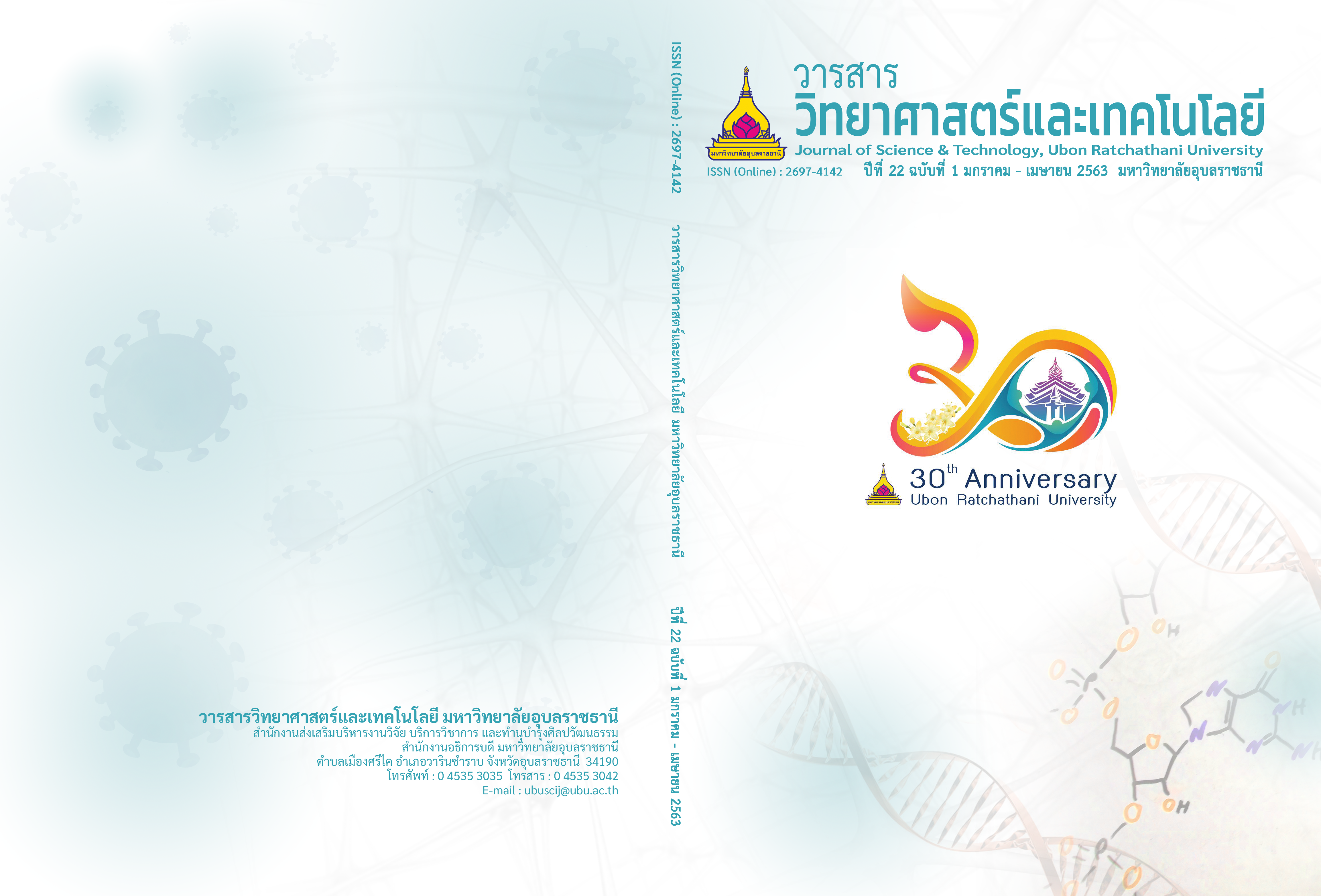องค์ประกอบชนิด และดัชนีความสำคัญสัมพัทธ์ของสัตว์น้ำจากการประมงลอบปูม้าแบบพับได้ ในอ่าวบ้านดอน จังหวัดสุราษฎร์ธานี
Main Article Content
บทคัดย่อ
การศึกษาองค์ประกอบชนิดสัตว์น้ำและดัชนีความสำคัญสัมพัทธ์ของชนิดสัตว์น้ำที่จับได้โดยเครื่องมือประมงลอบปูม้าแบบพับได้ในบริเวณอ่าวบ้านดอน จังหวัดสุราษฎร์ธานี ดำเนินการระหว่างเดือนตุลาคม พ.ศ. 2560 ถึงเดือนพฤศจิกายน พ.ศ. 2561 โดยลอบที่ใช้ศึกษาเป็นแบบพับได้รูปสี่เหลี่ยมขนาด 35x55x17 ลูกบาศก์เซนติเมตร แบ่งลอบออกเป็น 3 รูปแบบ ได้แก่ รูปแบบที่ 1 ขนาดตาอวน 1 นิ้วรอบตัวลอบ รูปแบบที่ 2 ขนาดตาอวนด้านข้างและด้านบน 1 นิ้ว และด้านท้อง 2.5 นิ้ว และรูปแบบที่ 3 ขนาดตาอวน 2.5 นิ้วรอบตัวลอบ ผลการศึกษาพบว่าสัตว์น้ำที่จับได้ทั้งหมดจำแนกได้เป็น 26 อันดับ 61 วงศ์ และ 118 ชนิด ลอบแบบที่ 1 จับสัตว์น้ำได้มากที่สุด (109 ชนิด) รองลงมาเป็น แบบที่ 2 และแบบที่ 3 จับสัตว์น้ำได้ 98 ชนิด และ 68 ชนิด ตามลำดับ ทั้งนี้พบว่าผลจับสัตว์น้ำทุกชนิดต่อหน่วยแรงงานของเครื่องมือประมงลอบแบบที่ 1 มีปริมาณมากกว่า แบบที่ 2 และแบบที่ 3 อย่างมีนัยสำคัญ (P value ≤ 0.01) ขณะที่ผลจับในเชิงจำนวนตัวและน้ำหนักของปูม้าจากเครื่องมือลอบทั้ง 3 ชนิด ไม่มีความแตกต่างกันอย่างมีนัยสำคัญ (P value ≥ 0.05) นอกจากนี้ดัชนีความสำคัญสัมพัทธ์ชี้ให้เห็นว่า ปูกะตอย ปูม้า ปลาปักเป้าลายพาดกลอน ปูเป้ใหญ่ เป็นสัตว์น้ำชนิดเด่นในพื้นที่พบได้ทั่วไปในอ่าวบ้านดอน การศึกษาครั้งนี้ชี้ให้เห็นชัดว่าลอบแบบที่ 1 มีสัดส่วนผลจับสัตว์น้ำพลอยจับได้ มากกว่าแบบที่ 2 และ 3 อย่างมีนัยสำคัญ ดังนั้นการส่งเสริมให้ชาวประมงปรับเปลี่ยนการใช้ลอบเป็นลอบแบบที่ 3 จะทำให้ลดการจับสัตว์น้ำพลอยจับได้โดยที่ผลจับปูม้าซึ่งเป็นสัตว์น้ำชนิดเป้าหมายไม่มีความแตกต่างจากการใช้ลอบรูปแบบอื่นอย่างมีนัยสำคัญ ทั้งนี้เพื่อทำให้การประมงปูม้าไม่ส่งผลกระทบต่อระบบนิเวศในบริเวณอ่าวบ้านดอนในระยะยาว
Article Details
บทความที่ได้รับการตีพิมพ์เป็นลิขสิทธิ์ของ วารสารวิทยาศาสตร์และเทคโนโลยี มหาวิทยาลัยอุบลราชธานี
ข้อความที่ปรากฏในบทความแต่ละเรื่องในวารสารวิชาการเล่มนี้เป็นความคิดเห็นส่วนตัวของผู้เขียนแต่ละท่านไม่เกี่ยวข้องกับมหาวิทยาลัยอุบลราชธานี และคณาจารย์ท่านอื่นๆในมหาวิทยาลัยฯ แต่อย่างใด ความรับผิดชอบองค์ประกอบทั้งหมดของบทความแต่ละเรื่องเป็นของผู้เขียนแต่ละท่าน หากมีความผิดพลาดใดๆ ผู้เขียนแต่ละท่านจะรับผิดชอบบทความของตนเองแต่ผู้เดียว
เอกสารอ้างอิง
[2] Miguel V. A., Cherry, P. A., Yousuke, K. and Sanae, T. (2007). Effect of two collapsible pot designs on escape rate and behavior of the invasive swimming crabs Charydis japonica and Portunus pelagicus. Fisheries Research, 85: (202–209).
[3] Juntarashote, K. (1998). Community based fishery management. Thai Research Funding Agency, Bangkok, Thailand. (in Thai)
[4] Sawusdee, A. (2007). Management proposal for Bandon Bay and its islands. Walailak University, Thailand. (in Thai)
[5] Holim, S. (2009). The preliminary study of catch efficiency of collapsible trap in Tungka Bay, Chumporn. Maejo University, Chumporn, Thailand. (in Thai)
[6] Phomikong, P., Hawanon, V. and Koonkalya, S. (2006). Species composition of crab trapin Ranong province. Proceedings of the 44th Technical Conference of Fisheries, Kasetsart University, Thailand. (in Thai)
[7] Jayangkoon, N. and Ekbao, C. (2014). The project of lesson development: Bandon ecosystem. Thai Research Funding Agency, Bangkok, Thailand. (in Thai)
[8] Niumnoot, N. and Purisumpun, R. (2014). Value chain of aquatic animals in Bandon Bay. Suratthani Rajabhat University, Suratthani, Thailand. (in Thai)
[9] Nelson, J. S. (2006). Fishes of the world (4th eds.). NJ: John Wiley & Sons.
[10] Carpenter, K. E. and Niem, V. H. (eds.). (1999a). The living marine resources of the Western Central Pacific (Volume 3. Batoid fishes, chiamaeras and bony fishes part 1 Elopidae to Linophrynidae). Rome, Italy: FAO Species Identification Guide for Fishery Purpose. Food and Agriculture Organization of the United Nations.
[11] Carpenter, K. E. and Niem, V. H. (eds.). (1999b). FAO Species Identification Guide for Fishery Purpose. The living marine resources of the Western Central Pacific. (Volume 4. Bony fishes part 2 Mugilidae to Carangidae). Rome, Italy: Food and Agriculture Organization of the United Nations.
[12] Carpenter, K. E. and Niem, V. H. (eds.). (2001a). The living marine resources of the Western Central Pacific. (Volume 5. Bony fishes part 3 Menidae to Pomacentridae). Rome, Italy: FAO Species Identification Guide for Fishery Purpose. Food and Agriculture Organization of the United Nations.
[13] Caddy, J. F. and Sharp, G. D. (1986). An ecological framework for marine fishery investigations. (Technical Paper 283). Rome, Italy: FAO Fisheries.
[14] Samukphan, L., Teanpru, P., Dumrungrote, P. and Kunsook, C. (2016). Biodiversity and utilization of bycatch species from collapsible crab trap in Kung Krabaen Bay, Chantaburi. Proceedings of the 7th Technical Conference of Plant Genetic Conservation Project Under the Royal Initiation of Her Royal Highness Princess Maha Chakri Sirindhorn, Chantaburi, Thailand. (in Thai)
[15] Oasompoon, P., Ubonsuwan, J. and Roungprim, R. (2006). The study of optimal trap mesh size for Blue swimming crab fishery in Phang Nga Bay. Fishery department, Bangkok, Thailand. (in Thai)
[16] Kunsook, C., Pangpaiboon, P., Puttarak, S., Sangsri, P. and Katinsri, S. (2016). The comparison of collabsible crab trap in Kung Krabaen, Chantaburi. Burapha Science Journal, 22: (96-109)
[17] Bootsun, S. and Arimato, T. (2011). The comparison of catch volume from crab trap fishery between small and large fishing boats in upper Gulf of Thailand. Proceedings of the 45th Technical Conference of Fisheries, Kasetsart University, Thailand. (in Thai)


